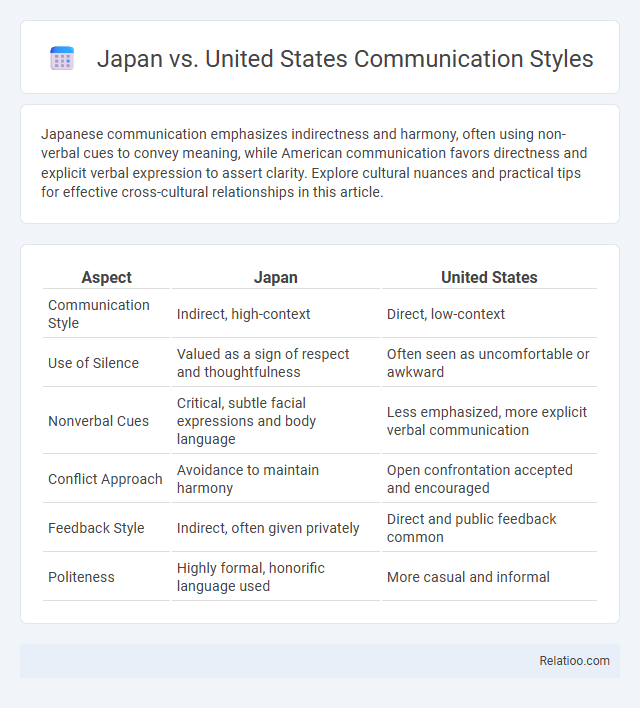Japanese communication emphasizes indirectness and harmony, often using non-verbal cues to convey meaning, while American communication favors directness and explicit verbal expression to assert clarity. Explore cultural nuances and practical tips for effective cross-cultural relationships in this article.
Table of Comparison
| Aspect | Japan | United States |
|---|---|---|
| Communication Style | Indirect, high-context | Direct, low-context |
| Use of Silence | Valued as a sign of respect and thoughtfulness | Often seen as uncomfortable or awkward |
| Nonverbal Cues | Critical, subtle facial expressions and body language | Less emphasized, more explicit verbal communication |
| Conflict Approach | Avoidance to maintain harmony | Open confrontation accepted and encouraged |
| Feedback Style | Indirect, often given privately | Direct and public feedback common |
| Politeness | Highly formal, honorific language used | More casual and informal |
Overview of Japan and United States Communication Styles
Japan's communication style is characterized by indirectness, high-context exchanges, and an emphasis on harmony and non-verbal cues, while the United States favors direct, low-context communication with clear, explicit messages. In Japan, subtlety and reading between the lines are crucial to understanding intent, whereas in the U.S., straightforwardness and verbal clarity are valued for effective interaction. Understanding these divergent cultural norms can help you navigate conversations more successfully and avoid misunderstandings.
High-Context vs Low-Context Communication
Japanese communication exemplifies high-context communication, where meaning is often derived from implicit cues, non-verbal signals, and the surrounding context, emphasizing harmony and group consensus. In contrast, the United States employs low-context communication, favoring direct, explicit verbal expression and clarity to convey messages efficiently and reduce ambiguity. Understanding these differences can help you navigate cross-cultural interactions by recognizing Japan's reliance on subtlety and the U.S.' preference for straightforwardness.
Directness and Indirectness in Conversation
Japan's communication style emphasizes indirectness, relying heavily on context, non-verbal cues, and implied meanings to maintain harmony and avoid confrontation. The United States favors direct communication, valuing clarity, explicitness, and straightforward expression to ensure efficient information exchange and assertiveness. These contrasting approaches highlight the cultural preference for subtlety in Japan versus the American inclination toward openness and transparency in conversation.
Verbal and Nonverbal Communication Differences
Japanese communication emphasizes indirectness, relying heavily on context, nonverbal cues like silence, subtle facial expressions, and polite language to convey meaning, reflecting a high-context culture. In contrast, the United States favors direct verbal communication with explicit messages, straightforward speech, and expressive body language, characteristic of a low-context culture. Nonverbal differences include Japan's restrained gestures and bowing versus the US preference for firm handshakes and open gestures, highlighting contrasting cultural norms in interpersonal interactions.
Role of Silence in Japanese and American Interactions
In Japanese communication, silence plays a crucial role as a form of respect, contemplation, and harmony maintenance, often signaling agreement or allowing space for thoughtful reflection. American interactions typically view silence as awkward or indicative of discomfort, prompting speakers to fill gaps with verbal expressions to maintain clarity and engagement. These contrasting interpretations of silence highlight the indirect communication style in Japan, where meaning is often conveyed implicitly, versus the direct communication preference in the United States, emphasizing explicit verbal exchanges.
Hierarchy and Respect in Communication
Japanese communication emphasizes indirectness, where hierarchy and respect play central roles, with individuals often using subtle language and non-verbal cues to maintain harmony and show deference to superiors. In contrast, the United States favors more direct communication, valuing clarity and assertiveness while still respecting hierarchy through formal titles and polite language. Understanding these cultural differences helps you navigate cross-cultural interactions effectively, fostering mutual respect and reducing misunderstandings.
Conflict Resolution Approaches
Japan emphasizes indirect communication in conflict resolution, prioritizing harmony, non-verbal cues, and subtlety to avoid open confrontation. In contrast, the United States favors direct communication, encouraging explicit expression of thoughts and assertive problem-solving to quickly address conflicts. Japanese conflict resolution relies on group consensus and preserving relationships, whereas American approaches focus on individual rights and transparent dialogue.
Business Communication Etiquette
Japanese business communication emphasizes indirectness, high-context messaging, and non-verbal cues to maintain harmony and avoid confrontation, reflecting the cultural value of wa (group harmony). In contrast, United States business communication adopts a direct, low-context approach where clarity, explicitness, and individual expression are prioritized to convey messages efficiently. Understanding these contrasting styles is crucial for successful cross-cultural interactions, ensuring respect for Japan's preference for subtlety and the U.S. focus on straightforwardness in professional settings.
Group Harmony vs Individual Expression
Japanese communication emphasizes group harmony through indirect expressions, valuing context and nonverbal cues to maintain social cohesion. In contrast, the United States prioritizes individual expression with direct, explicit communication aimed at clarity and personal opinion assertion. These divergent styles reflect cultural values where Japan's indirectness preserves collective unity, while American directness highlights personal identity and transparency.
Tips for Effective Cross-Cultural Communication
Japanese communication often relies on indirectness, emphasizing harmony and reading between the lines, while the United States favors direct, explicit exchanges that prioritize clarity and individual expression. To navigate these differences effectively, you should practice active listening, pay attention to non-verbal cues, and be mindful of context to avoid misunderstandings. Adapting your communication style by combining respectful subtlety with clear intent fosters better cross-cultural collaboration and mutual respect.

Infographic: Japan vs United States communication styles
 relatioo.com
relatioo.com